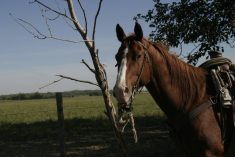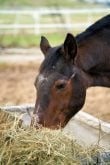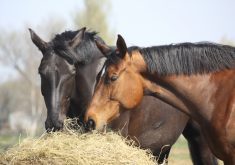Veterinary professionals and cat owners have recently begun diagnosing and addressing whisker stress or whisker fatigue in felines.
Simply put, the theory is that a cat’s whiskers can become over-stimulated from the unnatural habit of touching the sides of standard food and water dishes, leading to whisker stress or whisker fatigue.
Although there is no solid science to support the theory, this catchy diagnosis appears to offer a plausible explanation for a cluster of anxious behaviours shown by some cats at feeding time. These unusual behaviours in otherwise healthy cats include avoidance of food and/or water bowls, pacing or anxiety in front of the bowls, acting hungry but refusing to eat from a bowl, meowing as if distressed around feeding time, and pawing food out of the bowl and eating it on the floor. When owners changed the bowls to shallower ones, the cat’s eating habits improved and their behaviour settled down.
Read Also

A great idea for repurposing grain bins
The Morrison family of southern Alberta have transformed old grain bins into unique guest cabins.
The idea of whisker stress is not that far-fetched when the science of the whisker is explored.
Whiskers, also known by their scientific name ‘vibrissae,’ are different from regular hairs in their anatomy, location and purpose. They are much more than a superficial adornment and their complex sensory nature helps the animal navigate and interpret the what and where of their environment.
While the whisker hair itself does not ‘feel,’ it is anchored into a blood-rich follicular sac that is extensively innervated and feeds directly into the brain’s sensory cortex. This means the sensory messages from the whisker are significant enough to occupy dedicated brain space.
It is speculated this information pertains to the animal’s spatial awareness, navigation (especially in the dark), feeding and hunting behaviours, and communication among individuals. It may even provide input on air currents, air pressure and weather patterns.
Therefore it is reasonable that, much like any sensory organ, the whisker can suffer from overstimulation under the right circumstances.
Horses have whiskers too (on their muzzle, around their nostrils, mouth and chin), as well as around their eyes.
The job description of the whisker is relatively similar throughout the animal kingdom and so just like in the cat, the equine whisker colours the horse’s world and helps it make sense of its surroundings.
For example, whiskers help guide the highly dextrous muzzle of the horse through touch. Whiskers help the newborn foal find and latch onto the dam’s teats, and help the horse judge the distance of objects from their face and make further sense of the visual blind spot beneath their muzzle.
They are critical to spatial awareness because horses are unable to see objects directly in front of their eyes or below their nose. The sensory messages from whiskers are used to process information, including finding food, communicating during mutual grooming, and sensing environmental information.
Equine whiskers are also used as a form of body language and a means of silent communication. The highly tactile whiskers have blood-filled sacs at their base to amplify their movement and, to the astute observer, express information regarding the horse’s attitude.
Since humans lack the whisker, it can be difficult to appreciate the value of this information. Yet once its importance is understood and appreciated, it becomes difficult to defend the traditional convention of grooming and/or clipping whiskers for fashion or cosmetic reasons. Horses and cats will show strong objection to handling of their whiskers and if they are removed, the animal will quickly regrow them, which is perhaps a testimony to their necessity.
Equine behaviourists are now trying to understand how whisker trimming can affect behaviour and even compromise the safety of the animal, rider or handler.
It is important to be aware of these sensory organ hairs when interacting with horses, when reading their calming signals and when communicating with them. For example, some horses, particularly youngsters, are extremely sensitive to their whiskers being touched. When initially haltered, they may respond as if a raw nerve has been touched.
Others may withdraw as they attempt to make sense of the touch and still others may eagerly use their whiskers to ‘feel’ the human face or hand.
The whisker is a highly specialized sensory tool and exists to help the horse make sense of and feel safe in the world around it.
















